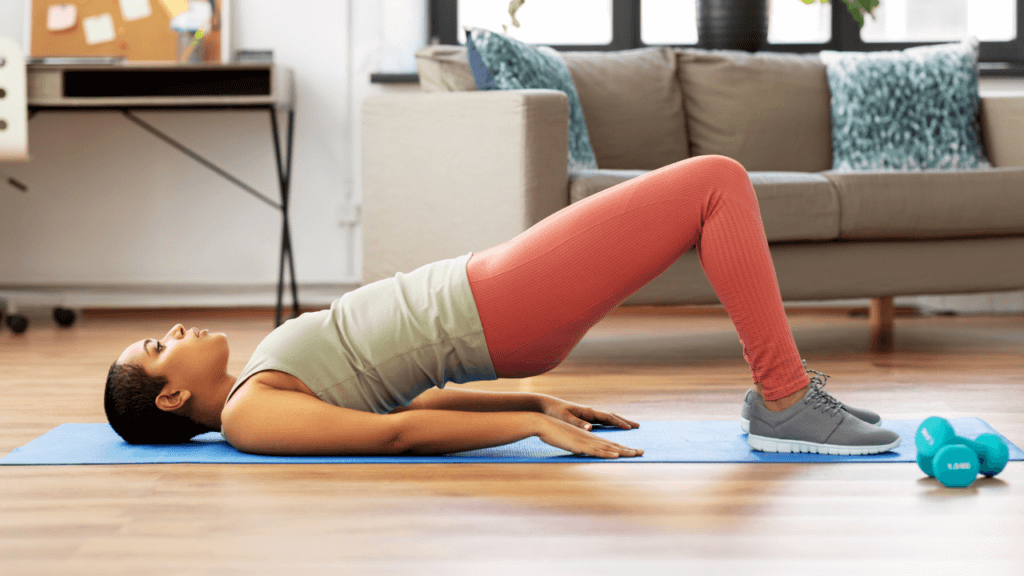Do you have incontinence, pelvic discomfort, constipation, pain during sexual activity, or pelvic organ prolapse that makes you stressed, anxious, or disappointed because you can’t take pleasure in the activities you love and the people you love?
Pelvic floor dysfunction can be caused by childbirth, trauma-related injuries, surgery, obesity, and nerve damage, but it is treatable!
You may be aware that pelvic floor exercises might assist with bothersome issues with the pelvic floor muscles.
This article will discuss 5 of the best exercises that you can do in order to strengthen the pelvic floor muscles, what those muscles do, and why it is important that you exercise those muscles. If you allow those muscles to get weak and they are unable to support the rest of the organs, it can cause life-altering issues and pelvic floor dysfunction.
Identifying Pelvic Floor Dysfunction And The Issues It Causes
Symptoms of pelvic floor dysfunction can be life-changing for lots of people.
The inability to properly relax and coordinate the muscles in your pelvic floor to pee or have a bowel movement is known as pelvic floor dysfunction. You could have discomfort when having sex if you’re a woman and men often deal with ED when their pelvic floor is not functioning properly. A collection of muscles called your pelvic floor may be discovered at the base of your pelvis at the bottom of your torso.
A pelvic floor acts as the foundation for organs like the bladder, uterus, and rectum. When it is not functioning as it should, the organs can also have issues in their functions and cause a number of issues. Trouble with bowel movements, urine or stool leaks, and pain during sex are often the common symptoms of issues with the muscles in your pelvis. It is important to strengthen these muscles to allow for the organs to do the things they need to keep the body healthy.
We are aware of how annoying this may be, and if you have encountered this issue, it’s probable that you are performing the exercises incorrectly or not at all. Finding out for sure that you are carrying out your treatment plan correctly is frequently a major advantage of consulting a pelvic health professional.
For some people who try to improve their pelvic floor health on their own, at home, it may be quite perplexing and stressful. The quickest and most efficient method to solve any problems with your pelvic floor is to have a professional work with you.
Additionally, not everyone should perform pelvic floor exercises. Pelvic floor exercises might not be the best course of treatment for you if you encounter pain, so stop doing them and get expert advice.
The 5 Best Ways to Strengthen Your Pelvic Floor
1. Kegel Exercises
- Start by lying on the floor with your feet flat on the ground and your knees bent. Try completing this exercise while sitting or standing as it is easier.
- Pulling your navel toward your spine while exhaling can help you swiftly contract and relax your pelvic floor muscles. Prior to releasing, try to contract for one second.
- Keep your breathing steady throughout.
- Ten fast flicks, followed by a 10-second break. Perform two to three sets.
2. Heel Slides
- Lay down on the floor with your legs bent and your pelvis in a neutral position.
- Exhale through your lips after taking a breath into your ribcage, allowing your ribs to naturally constrict.
- Slide your right heel away from you while raising your pelvic floor and locking your core. Go only as far as you can without losing touch with your innermost self.
- Once you’ve located the lowest position, inhale and raise your leg to the beginning position.
- Repeat.
- Before switching to the opposite leg, perform 10 slides on each side.
3. Diaphragmatic breathing
- Lay flat on the ground using a yoga or fitness mat to start. The workout may be done while seated as well.
- Practice increasing relaxation for a few seconds. Concentrate on relaxing your body’s stress.
- When you’re at ease, place one hand on your chest and the other on your stomach.
- To expand your stomach, take a nose-only breath in; your chest should remain mostly steady. Next, inhale for 2–3 seconds before gently exhaling.
- Keep one hand on the chest and the other on the stomach as you repeat numerous times.
4. Happy Baby Pose
- Lay down on your back. Put the knees into your abdomen and inhale deeply. Breathe in, place your hands on the soles of your feet, or wrap a strap or belt over each foot.
- Bring your knees up toward your armpits, opening them slightly wider than your body.
- Adjust your feet. Your shins should be parallel to the floor as you place each ankle precisely over the knee.
- As you bring your hands down to produce resistance, gently press your feet up into your hands (or the belts).
5. Toe Taps
- Lay down on the floor with your legs bent and your pelvis neutral.
- Exhale through your lips after taking a breath into your ribcage, allowing your ribs to naturally constrict.
- Lift your pelvic floor and tighten your abdominal muscles.
- Lift one leg gradually until it is perched atop a table.
- Bring this leg back to its starting position slowly.
- Repeat the motion while switching the legs. Your lower back shouldn’t be bothering you at all. Your deep core must remain active throughout the whole workout.
- Switch legs up 12–20 times total.
If you are experiencing pain when doing pelvic floor exercises, arrange a Free Pelvic Floor Specialist Visit
How Often You Perform Pelvic Floor Exercises
If you are doing the right pelvic floor exercises, and doing them right, that’s great!
But do you perform them frequently enough?
A professional may also help you with this so that you know when and how often to perform pelvic floor exercises so that you don’t perform them in excess or insufficiently.
However, depending on your circumstances, you should try to perform pelvic floor exercises a minimum of twice daily for most individuals.
How You Could Manage Your Overall Pelvic Floor Health
Our staff always uses a comprehensive approach to treatment, and pelvic floor exercises are simply one technique for treating pelvic floor issues. You may overcome pelvic floor issues by taking into account your water consumption, fiber intake, breathing patterns, stretching routines, and self-care practices.
Our staff is here to assist treat your pelvic floor difficulties quickly if you feel like you are doing everything right but are still dealing with pelvic floor issues that are stressing you out, making you uncomfortable, or significantly interfering with your life.
How To Strengthen Your Pelvic Floor Postpartum
Zone Physical Therapy would love to help answer your questions about the pelvic floor, how to strengthen it, and to do that we are currently offering a limited number of free Pelvic Floor Pain Assessments.
In our clinic, we are experiencing extremely high demand for pelvic floor physical therapy as more and more patients put their faith in natural pain relief and solutions to common postpartum problems such as incontinence, painful sex, and muscular aches.
Our team have helped hundreds of moms, just like you, improve their pelvic health and we would love to help you!
To arrange your free Pelvic Floor Pain Assessments – Request An Appointment or call us on (864) 351-7254.
Other Resources For Better Pelvic Health:
Read our blog – Do You Pee When You Jump, Cough, or Sneeze? Try These Tips!
Learn more about Pelvic Floor Physical Therapy – Pelvic Floor Physical Therapy Greenville, SC
Follow us on social media – Zone Physical Therapy Instagram


